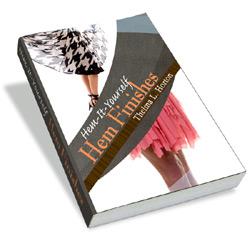
 |
 |
 |
 |
 |
 |
|
|
Home Sewing - How to Make Yours Not Look HomemadeMost
of us will agree that sewing
your own clothes saves you
money and
brings much satisfaction. It is gratifying when you complete
a
project and can say that you sewed it yourself. But, perhaps
the
biggest reason most people do not sew
their own clothes is because
they
look homemade. You start out with visions that the outfit
will
look exactly on you the way it looked on the pattern envelope, but when
it’s finished it looks like something is missing. And, you
can’t quite put your finger on what it is.
I remember staying up all night to finish outfits, so I would have something new to wear the next day for a special event or occasion. Even though I thought I looked cute, people could tell I'd made it the night before. The only time the iron touched it was when it was finished, and then I really ironed it… hard. I didn’t know what was missing until I stepped into a home economics sewing class, and saw a bunch of odd looking tools that I did not recognize, or know how to use. What I learned in that class, was the secret to making home sewing not look homemade was in the press, using those odd looking tools. I didn’t know that if I put off pressing the garment until completion, that it would be too late to set in the shape. I didn’t know that no matter how well I sewed, the professional look was also a result of proper pressing. Yes, properly pressing seams as you sew actually shapes the garment and sets the stitching lines. As we all know, the body is not flat, it has curves, and using the ironing board alone will not shape the garment properly. The only way to shape your garment is by using the proper pressing equipment along with the ironing board. If you are like me, and most home sewers, before taking a sewing class, you are also unfamiliar with specialized pressing equipment and not accustomed to using them. But, using the proper tools along with the proper techniques makes the difference in the end result. It helps shape the fabric so it will fit the body more smoothly.
Pressing is different from ironing. When most of us iron, we use a back and forth motion, moving the iron over the fabric. In pressing, the iron is lowered to the place to be pressed, then raised off the fabric, and moved to the next area. Ironing board covers should be 100% cotton because the all cotton fabric absorbs the moisture so that the fashion fabric will dry quickly. The traditional ironing covers with the reflective surface, actually reflects the steam, and may cause burn damage to some fabrics and slows down the drying process when you’re shaping with steam. First, be sure you know the fabric content to determine the proper heat setting for the iron, then follow the techniques below as you sew your garment pieces together. Press curved areas such as darts, hiplines, bustlines and collars over the tailor’s ham from the wrong side with the point of the dart smoothed flat over the end of the ham to shape their curve. Horizontal darts should be pressed down, and vertical darts should be pressed toward the center of the garment. Curved seams sometimes need to be clipped slightly along the edges so they can be pressed open without puckering. Do not clip any closer to the seam than absolutely necessary to press the seam flat. Be careful not to cut pass the stitched seam. Darts in heavy or bulky fabric will be less bulky if you slash, and then press open. Be careful not to slash so close to the point that the fabric will pull apart. Press seams open over sleeve or seam roll from the wrong side with the tip of the iron along the stitching line to prevent the seam edges from marking or showing through on the right side. Follow the grain line in the fabric when pressing by moving the iron in the same direction as the lengthwise yarns of the fabric. Pressing across the grain or on the bias can stretch the garment piece out of shape. Following the above guidelines will help you achieve professional-looking results in your sewing. So, instead of a homemade looking garment, proper pressing will give you professional results and a garment you’ll be proud to say, “I sewed it myself.” For a limited time you can download"Sew-It Like a Pro"And 2 FREE Bonus Books 
for
the incredibly low price of $27 and have it downloaded
to your computer in seconds!
Copyright (c) 2008 http://www.sew-it-yourself.com |
|||
|
| ©2006-2010. Sew-It-Yourself.com. All rights reserved. |